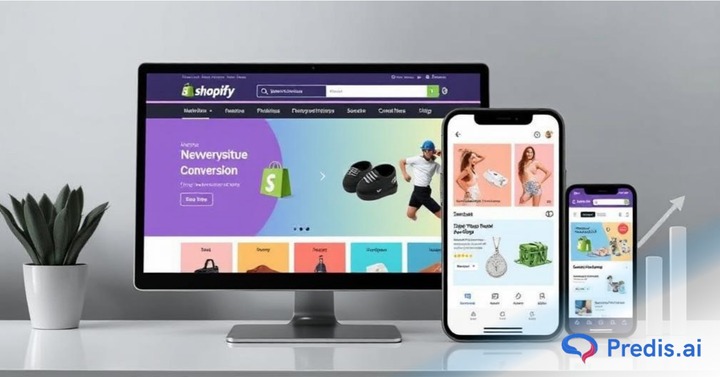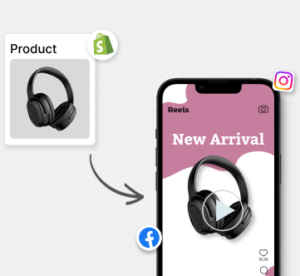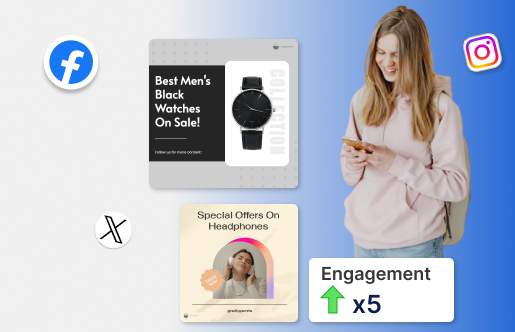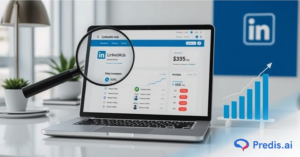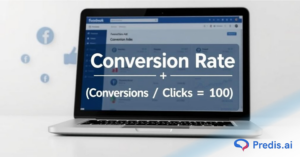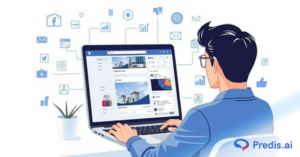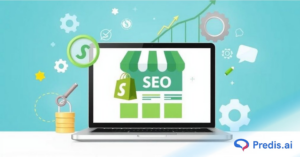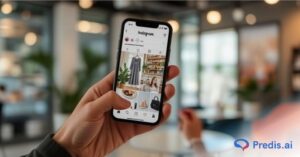So, you have an excellent collection of products in your Shopify store. Your reach and engagement numbers clearly show that they are generating a fair amount of buzz amongst your target audience. On the flip side, the bounce rate is off the charts, and your sales figures are in red. Are you sailing on the same boat? Want to know how to improve conversion of Shopify store?
If your answer is yes, you are in the right place. Making your customers part with their money is no easy feat, especially with today’s demanding customers. The plethora of options available to them and the fierce competition in the eCommerce space don’t make things any easier either.
That said, all is not lost. If your primary goal is to improve the conversion of your Shopify store, this blog is for you. We will cover several strategies you can use to improve your sales figures, along with a few tips and trips sprinkled in between. So, let’s get on with it.
E-Commerce Conversion Rate in a Nutshell
Before we take a deep dive into the “how” to improve the conversion of your Shopify store, let us first get a better understanding of what the metric “conversion rate” is.
Simply put, the Conversion Rate (CR), in the context of an online store, is the number of orders placed compared to the total number of visits to your store for a specific period. You can calculate this using the formula:
Conversion rate = Ordered Placed / Total visits to your online store
So, what should your conversation rate be for your Shopify store? This year, the average conversion rate of all Shopify stores was a mere 1.4%. The top 20% have a conversion rate of 3.3% or higher.
To put things into perspective, the average conversion rate of all e-commerce stores in the first quarter of 2024 stood at about 1.5%.
Whatever your current CR, there is always room for improvement, and the following strategies should help you do just that.
Effective Strategies to Increase Your Shopify Conversion Rate
As we have already established, your conversion rate depends on two primary factors: the total number of visitors to your store and the number of orders placed. So, essentially, we need a two-pronged approach to help improve the conversion rate: increasing website traffic and employing strategies to get customers to place those orders. So, let’s dive into them.
Strategies to Increase Traffic to Your Shopify Store
Improving your conversion rate is partly a numbers game, the more traffic you get to your store, the higher the probability of orders getting placed. Here is how you can do that.
1. Post Your Products on Pinterest
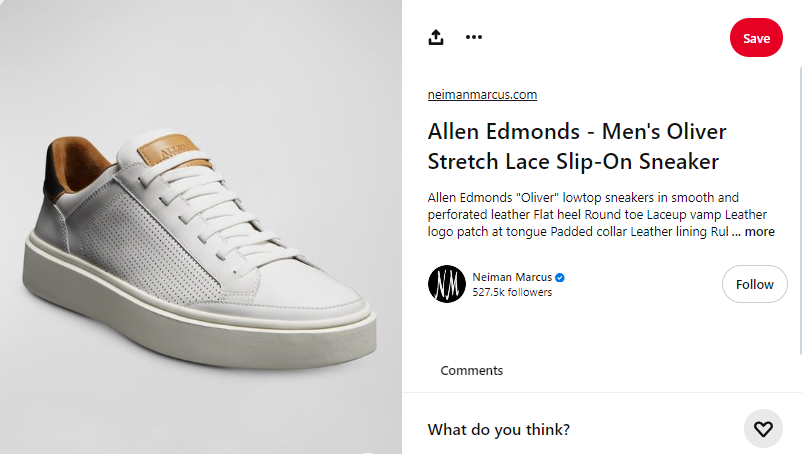
Pinterest is not among the most popular social media platforms (it is currently 15th). However, it still boasts nearly 500 million active users and is particularly popular in the US and the Netherlands.
Moreover, if Gen Z is your primary target audience, this is a platform to target as they make up nearly 42% of the active user base. Include high-quality images and videos to showcase your products. Include detailed product descriptions, and do not forget the link to the product on your Shopify Store.
Pro Tip: Use an automation tool like Predis.ai to create and post your marketing content to Pinterest along with other popular social media channels automatically. Use its AI capability to generate hashtags and captions for all your posts.
2. Focus on Your Marketing
No one will buy from you if they don’t know you exist. Organic growth is no doubt the best way to grow your audience but that is a process that takes time and patience. In the meantime, there are several other marketing strategies you can tap into to increase traffic to your Shopify store, such as:
i) Paid Advertisements
Platforms like Facebook and Instagram allow you to run paid ad campaigns. The advantage here is your ad campaigns can be targeted at a specific demographic or based on specific interests.
Pro Tip: Start with a tiny budget, experiment, perform A/B testing, measure the performance of your ad campaigns, and keep fine-tuning your strategies as you go along.
Boost your brand's visibility with eye-catching Facebook ads crafted effortlessly using Predis.ai's Facebook Ad Maker.
ii) Collaborate with Influences
Collaborating with the “right” influences is one of the best methods to put your brand out there. In fact, according to Influencer Marketing Hub’s The State of Influencer Marketing 2024 report, nearly 60% of their respondents are planning to increase their influencer marketing budget for this year. To make the most of your marketing budget, you can use the best accounting software for Shopify to track influencer payments, monitor campaign expenses, and ensure your spending stays aligned with your business goals.
Pro Tip: Follower count is not everything. Choose influencers with an active audience that aligns with your vision of your store.
3. Don’t Forget the Basics
More often than not, we get so caught up in ideation and strategizing that we tend to overlook the very basics – website/app optimization.
A recent study conducted by Salesforce revealed that over 50% of customers are more than willing to look elsewhere if they fail to provide a user-friendly mobile experience.
The same holds true for your Shopify website. Here is another statistic: nearly 50% of users wait no more than two seconds for a webpage to load before closing it and moving on.
Pro Tip: Use tools like Google Lighthouse to audit your Store’s webpage’s performance and take the necessary steps to improve it. Doing so will also help improve your page ranking, which can get you higher in the SERPs.
Strategies to Improve E-Commerce Conversion
The above strategies should help you increase the number of visitors to your store. Once they are there, the next step is to get them to convert and make that purchase. Here is how you can go about it.
1. Have Killer Product Pages
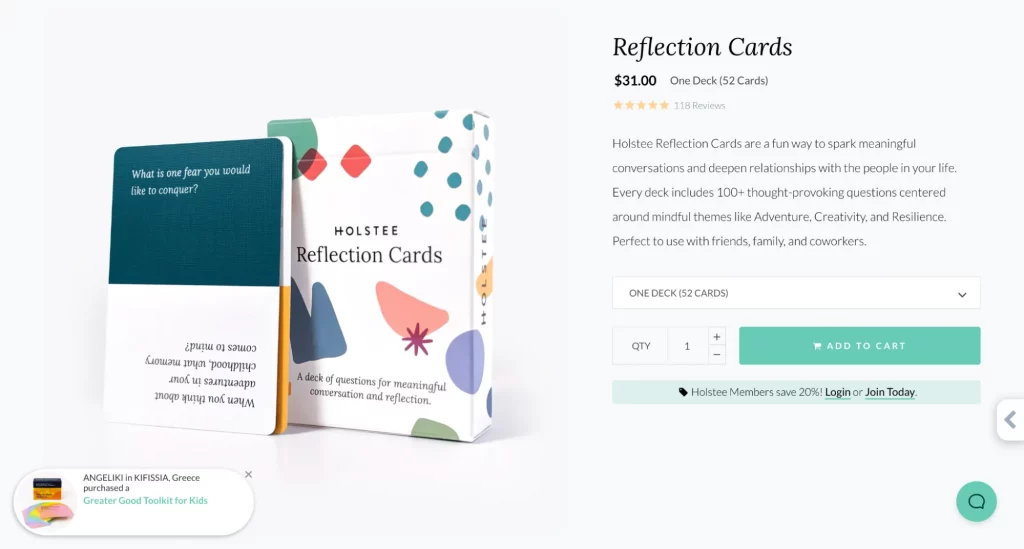
Your product pages can make or break a sale. Take a look at this page from Holstee. It has large, high-quality images of the product, a clear description of what the product is, the cost, buying options, and a clear CTA button.
Nothing too complex, neat, and simple does it.
Pro Tip: Include high-quality product videos on your landing pages.
2. Be Transparent with Pricing
We have all experienced this situation – you like a product, the price seems just right, and when you get to the checkout page, you see a bunch of additional charges (taxes, shipping, or a minimum order quantity, for example) added at the very end. Most of us end the transaction right there.
This phenomenon is called “Price Shock” and accounts for nearly 47% of people abandoning their shopping carts. Take, for example, this UK-based activewear brand called GymShark.
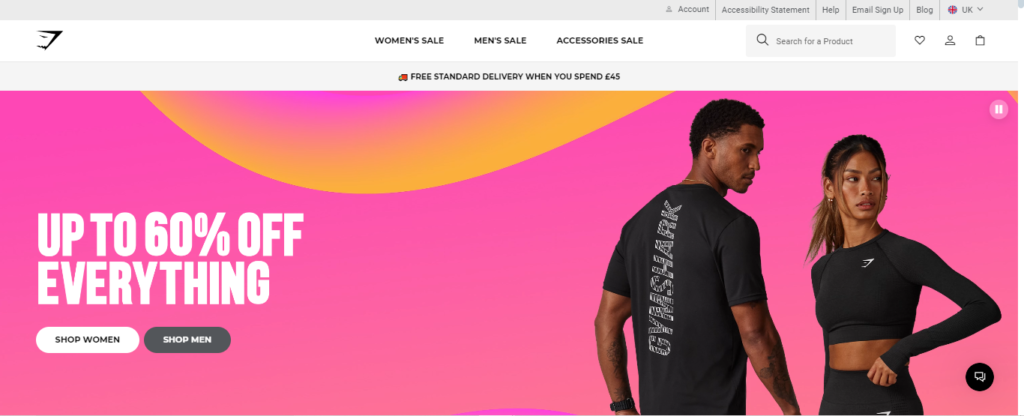
Their store clearly mentions that one needs to spend above a specific amount to get a free delivery. With no hidden surprises at the end, the higher the chances of a conversion.
3. Give Your Visitors a Guest Checkout Option
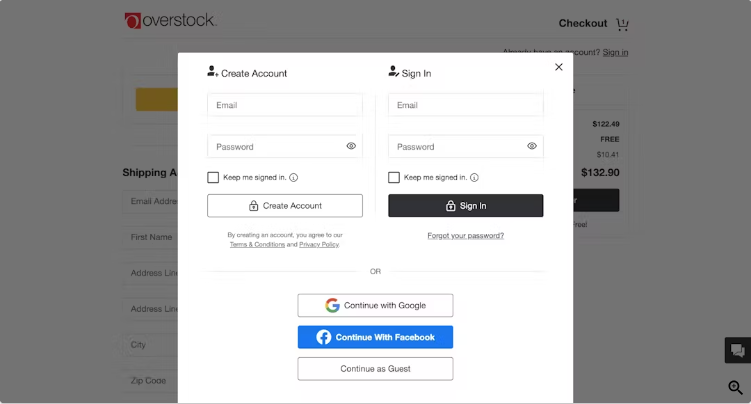
Customers have become a lot more cautious about giving out their personal information after the slew of data breaches that have been all over the news of late. There have been over 9000 publicly disclosed breaches this year alone.
Nearly 25% of users also don’t want to get into the hassle of having to create an account to checkout and abandon their carts. A guest checkout option will help appeal to those customers who don’t want to disclose their personal information and want a quick checkout option.
However, you should be aware that enabling this option will result in you losing the opportunity to capture a few key metrics.
Pro Tip: Use trust badges to build trust with your customers. An SSL certificate and security badges are a good start. Display your contact information and official address on your Shopify store and social media channels to further legitimize your online store.
4. Incentivise Your Customers Make a Purchase
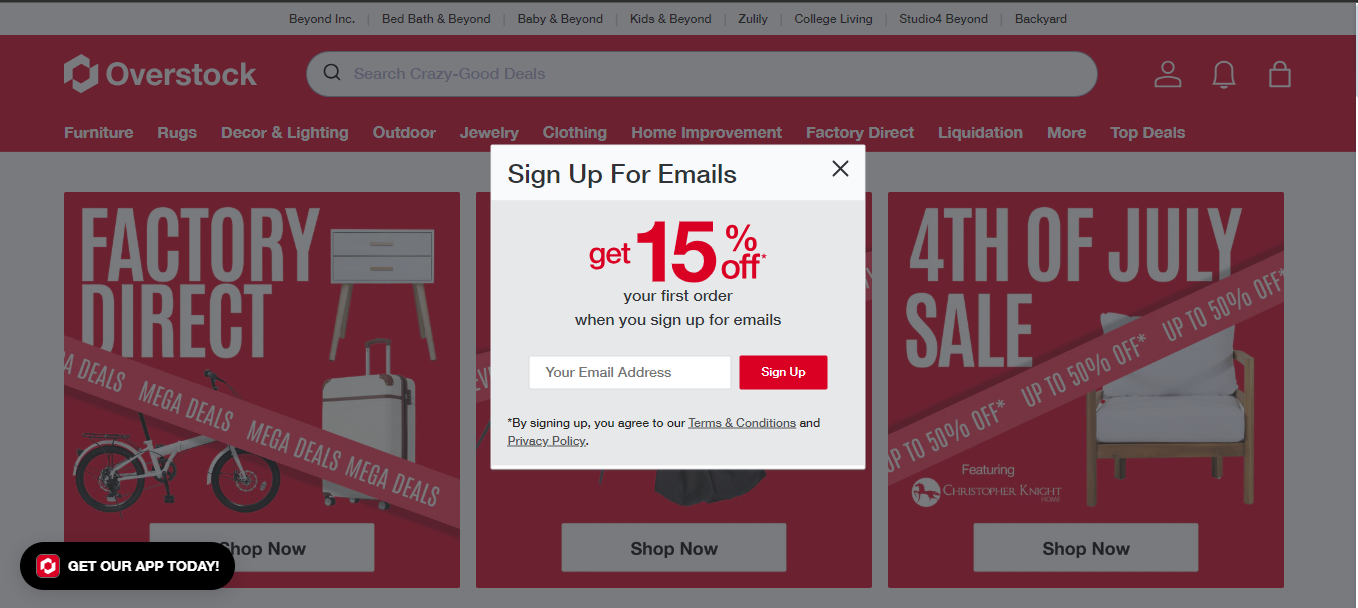
Signup offers are a great way to improve the conversion of your Shopify store, especially among your first-time customers. Overstock, for example, offers its customers 15% off when they sign up with their email for the first time.
Once customers sign up, you can continue incentivizing them for repeat purchases with exclusive offers and discounts. Once customers sign up, you can continue incentivizing repeat purchases by offering exclusive deals and discounts such as Free Gift With Purchase, Volume Discounts, or BOGO offers. You can also start a loyalty program with a tiered system that will further encourage them to return to your e-commerce store.
Use Predis.ai Free Call to Action (CTA) Generator for ecommerce. Improve your conversion rate with optimized Call to Actions generated using AI.
5. Highlight Social Proofs across Your Store
The opinions and experiences of others heavily influence your Customers. Nearly everyone (97%) makes buying decisions based only on online reviews. Positive reviews, especially, act as a form of social validation, assuring potential buyers they’re making a smart decision.4
In fact, statistics show that good reviews can incentivize customers to spend 31% more and that simply displaying customer reviews increases online purchases by a whopping 67%.
Partake Foods, a Shopify store that sells an assortment of cookies displays reviews its customers have left behind right on the product page to help influence their customer’s buying decisions.

Pro Tip: Sprinkle your social proofs across your store. For example, positive testimonials on your home page to create a strong first impression, star ratings on your product pages to gain valuable insights about the product before the purchase, and security badges on your payment pages reassure customers that their sensitive information is secure.
6. Use FOMO to Your Advantage
FOMO, short for Fear of Missing Out, is a great tactic to use to nudge your customers towards conversion gently. It taps into the human desire to be part of something exclusive or to avoid missing out on a great deal.
Rue Lala, a boutique clothing store, has a dedicated section called “Today’s Fix” where it offers a select item at a heavily discounted price every day.
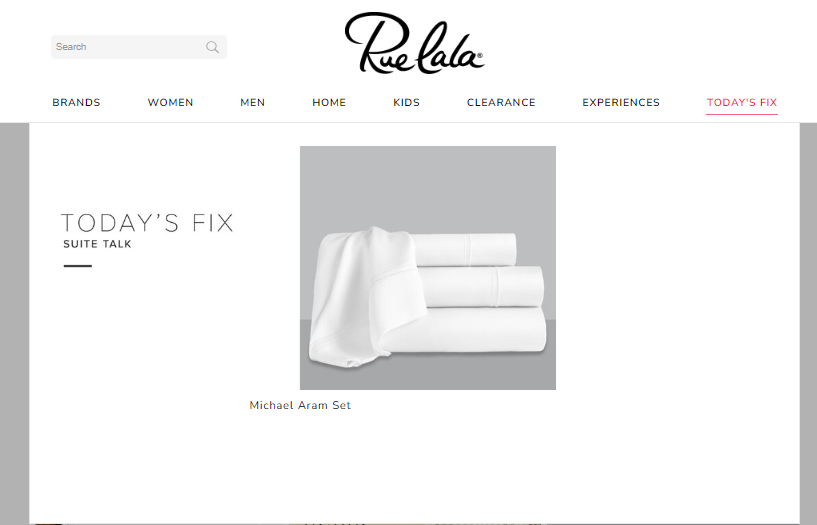
That said, discounts are not the only tactic you can use to induce FOMO. It can also be in the form of:
- Limited-Time Offers
- Limited Stock
- Scarcity Countdown Timers
- Time-limited Express Delivery
Amazon is a prime example of the latter. It offers free same-day delivery to its customers who place an order within a specific time period.
Pro Tip: Don’t overuse FOMO tactics. Doing so can backfire and erode customer trust. Instead, use FOMO strategically for specific promotions or limited-edition products.
7. Integrate a Support Feature Into Your Store
A seamless shopping experience is no longer a luxury when it comes to the world of e-commerce. Today, is a basic expectation.
Statistics show that 51% of consumers are more likely to be repeat customers if offered live chat support. Additionally, 52% of customers demonstrate increased brand loyalty when live chat support is available.
Integrating a support feature into your Shopify store will help you to address your customer’s concerns promptly and efficiently which can have a significant impact on your conversion rate.
Although Shopify doesn’t have a native support feature to integrate into your stores, several third-party applications can help you do the same.
8. Offers Your Customers A Seamless Checkout Process
A seamless checkout process is a sure-shot way to improve the conversion rate of your Shopify store. Statistics show that complex checkout processes account for nearly 18% of all cart abandonment.
Here’s how to optimize your Shopify checkout process for maximum conversion:
- Ask for vital information (such as name, address, contact information, and so on).
- Implement auto-fill for repeat customers.
- Offer multiple payment options to your customers.
- Implement progress bars or visual cues to indicate where your customers are in the checkout process.
- And finally, give them a guest checkout option (we have already covered the why).
Pro Tip: Clearly display your return and refund policy during checkout. Customers who are confident about your return policy are more likely to finalize their purchase. Nearly 60% of them go through it before making a purchase.
9. Re-Target Your Customers
Your customers could have abandoned their cart for any number of reasons and then forgotten about it over time. Re-targeting these customers with reminder emails is a great way to improve your conversation rate.
Peel, a Shopify store that sells bespoke phone cases, sends out reminders to its customers about items pending in their carts with the subject line “Still thinking it over?”
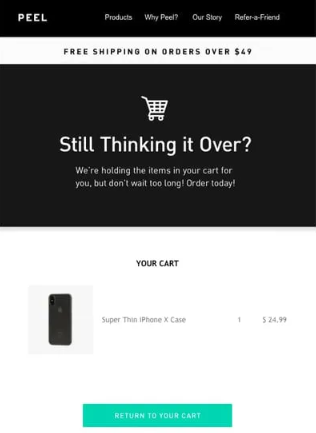
You can further incentivize your customers to complete that purchase with a one-time discount or free shipping.
Pro Tip: Automate your re-targeting email campaigns. In 2023, re-targeted emails had an Open Rate of 46.6% which resulted in an average conversion rate of 2.56%.
Pro Tip 2: Add images of the product your customer added to their cart along with a clear CTA to direct your customer to complete the purchase.
Boost Sales on Social Media with AI⚡️
TRY NOWSumming It up
Building a loyal customer base that keeps coming back to shop with you is a long-drawn process. That said, there is a lot you can do to improve the conversion of your Shopify Store right away.
This blog has unpacked thirteen result-oriented strategies you can leverage to drive up your sales figures. The crux of them is simple:
- Give your customers all the information they need to make a purchase (re-enforce that information with social proofs)
- Make their shopping experience simple and seamless across all devices.
- Entice, incentivize, and use a bit of FOMO to nudge them to make that purchase from the get-go.
However, keep in mind that these strategies are not set in stone. Keep analyzing your store’s performance and keep adapting these strategies to improve your conversion rates continually.
In this regard, you can consider Predis.ai to convert your static product photos into captivating videos in no time. Post product videos every day to earn 10X more revenue. Predis will scan your Shopify store to create amazing videos featuring your products.
FAQs
A good conversion rate can vary depending on your industry. However, the average conversion rate for Shopify stores sits around 1.4%. The top 20% of stores achieve a conversion rate of 3.3% or higher.
Shopify analytics provide valuable data on your conversion rate. You can access this information by navigating to “Reports” under the “Analytics” menu option in your Shopify admin panel.
To encourage your customers to complete their purchases, offer discounts, free shipping promotions, loyalty programs, and referral bonuses.
A guest checkout option might help you recover the 25% of customers who prefer not to create an account and disclose any personal data or simply prefer a quick and fuss-free checkout process. The flip side of giving customers that option is that you fail to capture key information that you can then use to analyze their behavior and preferences to create a more personalized shopping experience for them in the future.
There are several strategies you can use that are cost-effective to improve your Shopify Store’s Conversion rate:
i) Leverage social media platforms like Instagram and Pinterest to showcase your products organically.
ii) Partner with micro-influencers in your niche for targeted promotion.
iii) Use the plethora of free tools available on the internet to help improve your website performance and your SEO.
Related Content,


